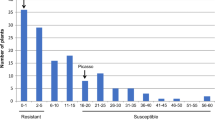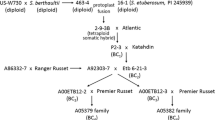Summary
A major dominant locus conferring resistance against several pathotypes of the root cyst nematode Globodera rostochiensis was mapped on the linkage map of potato using restriction fragment length polymorphism (RFLP) markers. The assessment of resistance versus susceptibility of the plants in the experimental population considered was based on an in vivo (pot) and an in vitro (petri dish) test. By linkage to nine RFLP markers the resistance locus Gro1 was assigned to the potato linkage group IX which is homologous to the tomato linkage group 7. Deviations from the additivity of recombination frequencies between Gro1 and its neighbouring markers in the pot test led to the detection of a few phenotypic misclassifications of small plants with poor root systems that limited the observation of cysts on susceptible roots. Pooled data from both tests provided better estimates of recombination frequencies in the linkage interval defined by the markers flanking the resistance locus.
Similar content being viewed by others
References
Bailey NTJ (1961) Introduction to the mathematical theory of linkage. Clarendon Press, Oxford
Bonierbale MW, Plaisted RL, Tanksley SD (1988) RFLP maps based on a common set of clones reveal modes of chromosomal evolution in potato and tomato. Genetics 120:1095–1103
Dellaert LMW, Vinke H, Meyer K (1988) The inheritance of resistance to the potato cyst nematode Globodera pallida PA3 in wild Solanum species with broad spectrum resistance. Euphytica 5:105–116
Gebhardt C, Ritter E, Debener T, Schachtschabel U, Walkemeier B, Uhrig H, Salamini F (1989) RFLP-analysis and linkage mapping in Solanum tuberosum. Theor Appl Genet 78:65–75
Howard HW, Fuller JM (1975) Testing potatoes bred from Solanum vernei for resistance to the white potato cyst nematode, Heterodera pallida. Ann Appl Biol 81:75–78
Jung C, Kleine M, Fischer F, Herrmann RG (1990) Analysis of DNA from a Beta procumbens chromosome fragment in sugar beet carrying a gene for nematode resistance. Theor Appl Genet, in press
Kort J, Ross H, Rumpenhorst HJ, Stone AR (1977) An international scheme for identifying and classifying pathotypes of potato cyst nematodes Globodera rostchoiensis and G. pallida. Nematologica 23:333–339
Lander ES, Green P (1987) Construction of multilocus genetic linkage maps in humans. Proc Natl Acad Sci USA 84:2363–2367
Little RJA, Rubin DB (1987) Statistical analysis with missing data. Wiley, New York
McMullen MD, Louie R (1989) The linkage of molecular markers to a gene controlling the symptom response in maize to maize dwarf mosaic virus. Mol Plant Microbe Interact 2:309–314
Medina-Filho HP, Stevens MA (1980) Tomato breeding for nematode resistance: survey of resistant varieties for horticultural characteristics and genotype of acid phosphatase. Acta Hort 100:383–391
Morton NE, MacLean CJ, Lew R, Yee S (1986) Multipoint linkage analysis. Am J Hum Genet 38:868–883
Mugniéry D, Balandras C (1986) Mise au point d'un test de résistance précoce des pommes de terre à Globodera sp. Potat Res 29:45–53
Ritter E, Gebhardt C, Salamini F (1990) Estimation of recombination frequencies and construction of RFLP linkage maps in plants from crosses between heterozygous parents. Genetics 125:645–654
Ross H (1962) Über die Vererbung der Resistenz gegen den Kartoffelnematoden (Heterodera rostochiensis Woll.) in Kreuzungen von Solanum famatinae Bitt. et Wittm. mit Solanum tuberosum L. und mit S. chacoense Bitt. Der Züchter 32:74–80
Ross H (1986) Potato breeding — problems and perspectives. Z Pflanzenzüchtung, Beiheft Nr. 13
Sarfatti M, Katan J, Fluhr R, Zamir D (1989) An RFLP marker in tomato linked to the fusarium oxysporum resistance gene 12. Theor Appl Genet 78:755–759
Tanksley SD, Young ND, Paterson AH, Bonierbale MW (1989) RFLP mapping in plant breeding: new tools for an old science. Biotechnology 7:257–264
van Daelen RAJ, Jonkers JJ, Zabel P (1989) Preparation of megabase-sized tomato DNA and separation of large restriction fragments by field inversion gel electrophoresis (FIGE). Plant Mol Biol 12:341–352
Young ND, Zamir D, Ganal MW, Tanksley SD (1988) Use of isogenic lines and simultaneous probing to identify DNA markers tightly linked to the Tm-2a gene in tomato. Genetics 120:579–585
Author information
Authors and Affiliations
Additional information
Communicated by J.A. Campos-Ortega
Rights and permissions
About this article
Cite this article
Barone, A., Ritter, E., Schachtschabel, U. et al. Localization by restriction fragment length polymorphism mapping in potato of a major dominant gene conferring resistance to the potato cyst nematode Globodera rostocbiensis . Molec. Gen. Genet. 224, 177–182 (1990). https://doi.org/10.1007/BF00271550
Received:
Issue Date:
DOI: https://doi.org/10.1007/BF00271550




